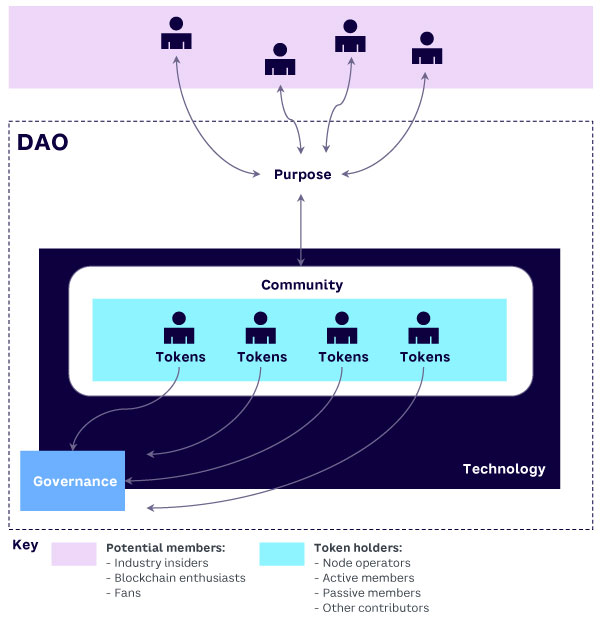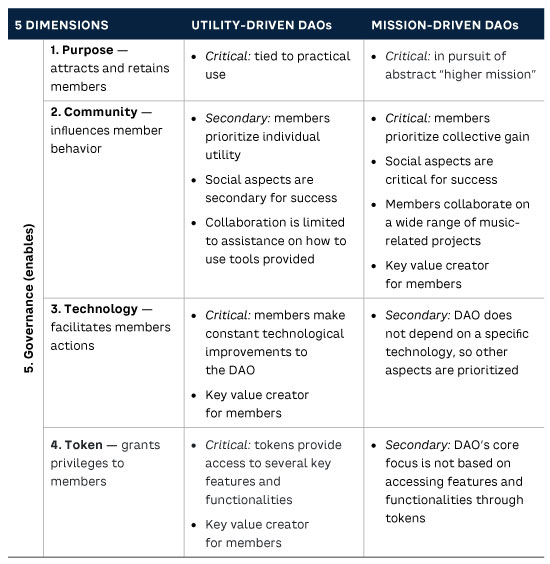AMPLIFY VOL. 35, NO. 10

Diego Alvarez, Pietro Cortellini, and Emily Munchak invite readers to look at DAOs through the lens of the music industry. The authors investigated three DAOs: Audius, BitSong, and MODA DAO, which aim to disrupt their market. The study differentiates between DAOs driven primarily by economic incentives from those focused on social incentives and highlights five dimensions that characterize all DAOs: purpose, community, technology, tokens, and governance. The study focuses on DAOs from the music industry, but the authors offer generalized insights for other industries.
Organizations have existed since the dawn of mankind, but blockchain technology is enabling the evolution and acceleration of innovative organizational forms. As emerging blockchain-based organizations, decentralized autonomous organizations (DAOs) have the potential to profoundly impact society. In this article, we examine how DAO characteristics have affected the success of three music-oriented DAOs.
DAOs present one of the most exciting prospects for blockchain 3.0 — the potential to disrupt entire industries and the way people organize. As such, DAOs are particularly suited to the music industry, where the disintermediating force of the technology can address some critical value chain flaws.
DAO founders and members should be able to leverage the learnings we share here to make more informed decisions and improve DAO success rates. Our findings also provide industry leaders and technology enthusiasts with a glimpse at how to remain resilient in the face of a potential grand-scale disruption to the way people collaborate.
How DAOs Are Remixing the Music Industry
From the earliest societies to the 21st century, technology has created opportunities for social and economic coordination. Today, blockchain is being applied across an array of industries to eliminate middlemen and has the potential to disintermediate the music industry, shifting the power back to artists.
Web3, the newest iteration of the Web, is built on blockchain protocols, encompassing cryptocurrencies, non-fungible tokens (NFTs), and other modern tools that are revolutionizing the way people interact with technology and each other. More recently, blockchain technology’s digital infrastructures have supported the establishment of DAOs. Although they’re experiencing dramatic growth, DAOs remain widely under-researched and misunderstood.
The music industry has long experienced deep-rooted problems that hinder creator satisfaction. Since the advent of recorded music, every music industry iteration has been built on technological advancements, forcing it to adapt. The Internet contributed to creator frustration by making music easily accessible to consumers while not financially rewarding musicians appropriately. In an industry where issues relating to intellectual property are rampant and vast amounts of value are lost to intermediaries, blockchain is poised to bring value back to the creators.
Only 27% of streaming revenue reaches creators, with the remaining 73% shared among the rest of the industry.1 Music industry insiders have identified DAOs as a means to resolve these pressing issues. There are currently more than 30 self-proclaimed music DAOs, some of which have attracted notable investors and artists.2
To address the gap between DAO awareness and adoption, along with the prevalent misconceptions and skepticism surrounding them, we seek to understand why some DAOs succeed and others fail through an industry-specific lens. As we do so, we’ll develop industry-specific knowledge that can be amplified beyond the constraints of our investigation. This may accelerate DAO adoption and help debunk misconceptions about their effectiveness for widespread organizations (as opposed to the small-scale organizations we see today).
3 DAOs
We examined three music-oriented organizations (Audius, BitSong, and MODA DAO) from their inception until 25 April 2022.
Audius is the oldest and most established DAO of the cases we researched. It was founded in 2018 on the Ethereum mainnet but has since expanded to the Solana blockchain for scalability. Audius centers around a decentralized application (dApp) that resembles popular traditional music streaming platforms like Spotify. A dApp behaves like any other app, except it is built on blockchain technology. In contrast to a centralized application, it relies on smart contracts on a distributed network.
Audius has achieved relative success, growing to more than 33,000 members and exhibiting an impressive compound annual growth rate (CAGR) of 192.92% of its token price over 17 months.
BitSong was established in 2018 and also revolves around a music-streaming dApp. It first built its ecosystem on Ethereum and later built its own layer 1 infrastructure on Cosmos, which went live in 2020. Despite commonalities with Audius, BitSong is not as successful. It demonstrated an admirable CAGR of 134.49% over almost one year but has only 1,400 members.
MODA DAO, established in 2021, is a multi-chain DAO, building parts of its ecosystem on Ethereum but relying on the Polygon sidechain and Fantom for scalability. Unlike Audius and BitSong, its dApp is underdeveloped and is not a key feature of the organization. MODA has a token-price CAGR of -95.89% over three months, which from a market perspective is a failure. However, MODA has more than 2,600 members despite being founded only a year ago.
All three DAOs we studied aim to use blockchain technology to solve the problems stemming from non-value-adding intermediaries. Audius and BitSong both have explicitly defined objectives concerning the disintermediation of the value chain and the enhancement of the relationships between artists and fans. MODA’s objectives are more theoretical and open to the influence of its members.
Audius and BitSong project themselves as decentralized alternatives to mainstream music-streaming platforms while MODA’s objective is to explore the wide range of opportunities of Music3. A MODA white paper describes Music3 as “a broad label referring to a new set of interconnected technologies, projects, companies, approaches, and ideologies designed to harness Web3 distributed technologies for the purpose of creator empowerment and deeper connection between creators and fans,”3 a more abstract and ambitious goal.
Our analysis generated several discoveries. First, we identified five fundamental dimensions characterizing DAOs. Second, we observed that DAOs can be divided into two types: utility-driven and mission-driven. Third, we learned that their success must be assessed depending on their type. Fourth, we found that purpose, tokens, and technology are critical to the success of utility-driven DAOs while purpose and community are critical to the success of mission-driven DAOs. And fifth, although governance mechanisms are fundamental to DAOs, they do not drive their success.
5 Fundamental Dimensions of DAOs
These fundamental dimensions represent the common features across the DAOs we studied:
-
The purpose dimension indicates how a DAO pursues its objectives and how its members gain value from the organization, encompassing all its activities.
-
The community dimension revolves around the people who make up the organization, including their characteristics and behavior, as well as the policies that shape them. This describes the members from a social standpoint, rather than merely reporting the fact that DAOs require members to sustain them.
-
The technology dimension relates to the organization’s technical infrastructure, architecture, applications, and members’ interaction and experience with the DAO’s interfaces.
-
The token dimension includes the organizations’ respective tokens, tokenomics, and the tokens’ features, plus anything that affects member utility gained from the use of tokens.
-
The governance dimension encompasses the mechanisms and processes affecting the DAOs’ distributed decision making, including coordination mechanisms, voting procedures, and quorums.
To summarize, the community is comprised of members who are assembled around a common purpose and determine the direction of the organization through participation in governance, which is facilitated by tokens and technology.
Figure 1 shows the relationships between the five fundamental dimensions. Potential contributors join a DAO because they are drawn to its purpose. Once they acquire tokens, they become contributing members of the DAO community, taking on a variety of roles. Some of these are infrastructural and shared across DAOs; others depend on the specific purpose and operations of the organization.

The community continually shapes the direction of the DAO as its members change over time. The figure demonstrates this with double-sided arrows: potential contributors join because of the purpose, but existing members use this to assess the DAO and may leave if dissatisfied.
The underlying technology layer provides the infrastructure for individuals to interact. Tokens grant members voting power in the governance process, shown through the connection between community and the governance dimension. The governance dimension is shown on the edge of technology but squarely within the constraints of the DAO. It can be orchestrated either on or off chain but, regardless, is an instrumental element.
DAO Classification: Crucial When Assessing Success
The five fundamental dimensions are important when assessing a DAO and can help us further categorize them (see Table 1).

For example, Audius and BitSong both rely on dApps. Based on their frequent discussion and governance proposals aimed at addressing the dApps, especially with regard to features and functionalities, members highly value this aspect of the DAOs. MODA’s dApp is crude, lacks basic functionality, and did not receive the same attention from its members.
We found in our analysis that Audius and BitSong members are more interested in the tangible aspects of the organizations, from which they derive practical use. Conversely, MODA members are focused on a variety of projects and collaborations in pursuit of complex goals for collective benefit, rather than individual gain.
Taking this a step further, we noted that Audius and BitSong members prioritize the practical use afforded by the DAO and their ability to profit from their affiliation with the organization over its social aspects. Audius and BitSong can thus be categorized as a different type of DAO from MODA since their goals, core activities, and member preferences are divergent. We use the terms utility-driven (Audius and BitSong) and mission-driven (MODA DAO).
Since utility-driven DAOs represent Web3 alternatives to existing platforms, which are driven by profit, they should be evaluated by how well they perform their practical function. Conversely, mission-driven DAOs are driven by objectives toward achieving a higher mission and should be evaluated based on the progress of their pursuit of this theoretical goal.
For this reason, we decided to rely on market value as a proxy measure of success for utility-driven DAOs, since the market value can be interpreted as a quantitative representation of the perceived value they produce. Community growth represents the key proxy measure of success for mission-driven DAOs, as it reflects the adoption of the organizational purpose and signifies the aggregation of resources from a wider pool of individuals in pursuit of their goals.
Regardless of the type of DAO, purpose is a crucial feature; without a clear purpose, DAOs lack a north star to guide their members and struggle to execute against their goals and evolve as necessary. Additionally, members evaluate the organizations based on their interpretation of their purpose, and their dissatisfaction grows if the DAO fails to deliver it.
If a DAO’s purpose is intrinsically tied to a dApp, and it does not provide its members with one that meets their expectations, it will likely fail. Likewise, if an organization’s purpose is more conceptual and does not tie itself to the development of a specific application, members will not evaluate it based on these criteria. Therefore, purpose is critical to the success of either type of organization, as it contextualizes how members should evaluate and participate.
Drivers of Success for Utility-Driven DAOs
The technology and token dimensions allow members to access the features and functionalities enabled by the DAO. Given that a utility-driven DAO’s primary focus is to operate a dApp, its technology must offer strong usability; anything else leads to confusion and/or frustration, resulting in members leaving the dApp and the DAO.
Furthermore, since many core features are restricted solely to token holders, tokens must provide members utility and facilitate their continued use of the dApp. For example, in both BitSong and Audius, governance proposals overwhelmingly address their technology and token, such as both organizations’ migration from Ethereum’s blockchain due to member concerns and the subsequent changes to their ERC-20 tokens. Mission-driven DAOs avoid tying their purpose to a dApp, emphasizing other aspects as the key value creators for members, causing their technology and token to be secondary to their success, as long as they meet a certain threshold of usability.
Drivers of Success for Mission-Driven DAOs
The community dimension is critical for mission-driven DAOs because they don’t rely on a dApp to attract and retain members. People join these organizations to engage with like-minded individuals and extract the most value from the social aspects of DAOs through their collective pursuance of a mission they champion.
For example, MODA members display a distinct interest in community participation, collaborating on musical projects and supporting each other, even beyond the scope of the DAO. Despite the technology being underdeveloped relative to the other organizations, this does not appear to be a major pain point for members.
In contrast, Audius and BitSong members are fixated on the aspects of the technology and tokens they perceive as pain points, such as high gas fees and challenges relating to using tokens. Clearly, an emphasis on community-building efforts must be more prominent in mission-driven DAOs than in their utility-driven counterparts.
Secondary Drivers of Success for DAOs
Distributed decision making is undoubtedly a key feature of DAOs, enabling members’ dual role as actors and owners to align their interests with the success of the organization and resolving the “principal-agent problem” (a conflict in priorities between the owner of an asset and the person to whom control of the asset has been delegated).4
However, our findings suggest that despite governance being a fundamental dimension for all DAOs, the mechanisms themselves are not a key driver of success in either mission-driven or utility-driven DAOs because they do not add value to members. In other words, the substance of governance proposals is critical to their success, but mechanisms and processes are not.
The matter of governance directly addresses DAO members’ interests and leads to the discovery that members in music-oriented DAOs have the power to initiate change as owners and members of the organizations. This can be seen by the majority of Audius’s and BitSong’s proposals addressing their tokens and technology and through MODA releasing a grant proposal to support an emerging musician who is a member of the community. The fact that governance can amend all the other dimensions suggests that governance can be thought of as an enabler of the other dimensions.
Implications for DAOs Beyond Music Industry
Our investigation focused on the music industry, but our findings can be applied to DAOs across industries since the key learnings are about DAOs as a tool for coordinating people and resources. The five dimensions we defined do not exist solely in the music industry but in all DAOs.
Regardless of the space in which a DAO operates, it requires: (1) a purpose that motivates members to join and stay and (2) an engaged community assembled around a common purpose that determines the direction of the organization through (3) a governance mechanism that facilitates member participation in decision making, (4) a token that enables members to contribute to the organization, and (5) a technology that facilitates the efficient operation and maintenance of the organization.
Our conclusions are applicable to many industries, especially those exhibiting highly intermediated value chains and low-value capture by value creators. For example, in the fashion industry, a utility-driven DAO could be designed to create and manage a decentralized marketplace or a platform for tokenizing luxury fashion.
A mission-driven DAO in the fashion industry could create a community of fashion designers by creating a space for them to collaborate, helping them coordinate and collectively pursue projects for the betterment of the overall community.
In the financial services industry, a utility-driven DAO could be designed to drive infrastructure development for future decentralized finance protocols. A mission-driven DAO in the financial services space could bring together financial services professionals, lawyers, and other experts to collaborate on projects and represent their interests to financial regulatory bodies.
Our conclusions are important for DAO founders and members, regardless of industry. They can be distilled into the following actionable insights:
-
DAOs can be identified as utility-driven or mission-driven.
-
Utility-driven DAOs can be measured based on their market performance, while mission-driven DAOs should be assessed on their ability to establish a solid community that pursues its “higher mission.”
-
DAOs can benefit from establishing a clear purpose early in development, so community members can easily understand the present and future goals of the organization.
-
As the purpose is what attracts members to join and remain in a DAO, it is important that all activities are in line with its purpose.
-
Mission-driven DAOs benefit from an engaging, collaborative community that fosters a unified identity that prioritizes collective needs over individual needs.
-
Utility-driven DAOs benefit from a functional token that members can easily acquire, transfer, and use, as well as from technology that supports their purpose.
-
Because governance mechanisms are merely enablers of the other dimensions, they are secondary as long as they are designed to mitigate problems that arise from the features of the community, ensuring that members’ goals and concerns can be regularly addressed through the substance of proposals.
Conclusion
Understanding DAOs’ best practices and focal success drivers is critical to determining whether this organizational form will thrive in the future. Early attempts at establishing DAOs were hindered by a few high-profile hacks that led to distrust and skepticism about their viability.5 It is still uncertain whether this will affect DAOs’ potential to become the main organizational form replacing how for-profit and social firms coordinate today. At the moment, their future looks promising: the number of DAOs increased from 700 in May 2021 to 6,000 in June 2022.6 The highly publicized success of a few large DAOs could help this organizational form gain credibility, further accelerating its adoption.
References
1 Mogis, Jay. “MODA DAO: The Genesis of Music3.” The MODA Music Foundation Industry, December 2021.
2 “The State of Music DAOs.” Water & Music, 7 March 2022.
3 Mogis (see 1).
4 Samman, George, and David Freuden. “DAO: A Decentralized Governance Layer for the Internet of Value.” May 2020.
5 “What Was the DAO?” Cryptopedia, 16 March 2022.
6 Newar, Brian. “Number of DAOs Increases 8x Along with a Spike in Votes and Proposals.” Cointelegraph, 10 June 2022.





